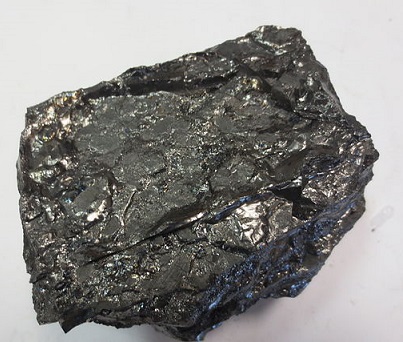Anthracite

Coal is a rock made of almost pure carbon. The coal in different deposits have different compositions, therefore, coal is classified in various categories Anthracite categorized as a dark black form of coal and the highest quality grade. It is very hard, has a low moisture content—and a carbon content of nearly 95%.[2][3] Also, anthracite is usually the oldest type of coal, having formed from biomass that was buried 350 million years ago.
The formation of anthracite not only takes a long time, but also requires very high temperatures. The temperatures necessary for the development of anthracite coal are only possible on the borders of mountain belts. These regions are suitable because the process of building a mountain pushes sheets of rock over the layers where coal is being formed. This results in the layers containing coal being pushed down to depths of 8 to 10 km—where the temperature can reach 300°C.[4]
Use
Anthracite can be used in household applications, primarily as a component of charcoal briquettes.[5] In addition, anthracite is used for space heating as it is one of the cleanest types of coal to burn—producing less smoke than other types. Its clean burning properties allows anthracite to burn longer than wood, making it appealing to use in home heating stoves.[6] Along with being clean and long burning, anthracite is used because it has a very high energy density—33 MJ/kg—the highest of any type of coal.[3] When burned, anthracite can reach very high temperatures, making this fuel exceptional at heating up quickly, releasing immense amounts of energy and burning very hot.[4]
For Further Reading
- Coal formation
- Coal combustion residuals
- Charcoal
- Carbon
- Hydrocarbon combustion
- Or explore a random page
References
- ↑ Wikimedia Commons. (May 13, 2015). Anthracite Coal [Online]. Available: http://commons.wikimedia.org/wiki/File:Anthracite_Coal.JPG
- ↑ J. Kraushaar, R. Ristinen. (May 11, 2015). Energy and the Environment, 2nd ed. Hoboken, NJ, U.S.A.: John Wiley & Sons, 2006, pp. 50
- ↑ 3.0 3.1 P. Breeze, Coal-Fired Generation. Elsevier Science, 2015.
- ↑ 4.0 4.1 Stephen Marshak. (May 13, 2015). Earth: Portrait of a Planet, 3rd ed. New York, NY, U.S.A:W.W. Norton & Company, 2008
- ↑ Canadian Federation of Earth Sciences. (May 11, 2015). Four Billion Years and Counting: Canada's Geological Heritage, 1st ed. Toronto, ON, Canada.: Nimbus Publishing, 2014
- ↑ Wendy Lyons Sunshine. (May 13, 2015). Anthracite Coal [Online]. Available: http://energy.about.com/od/Coal/a/Anthracite-Coal.htm

